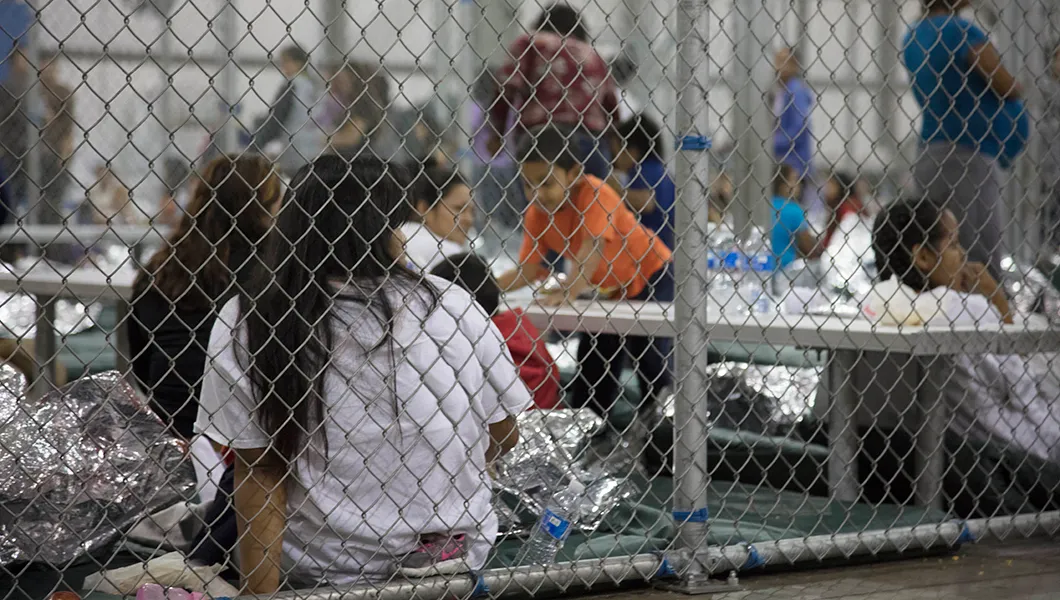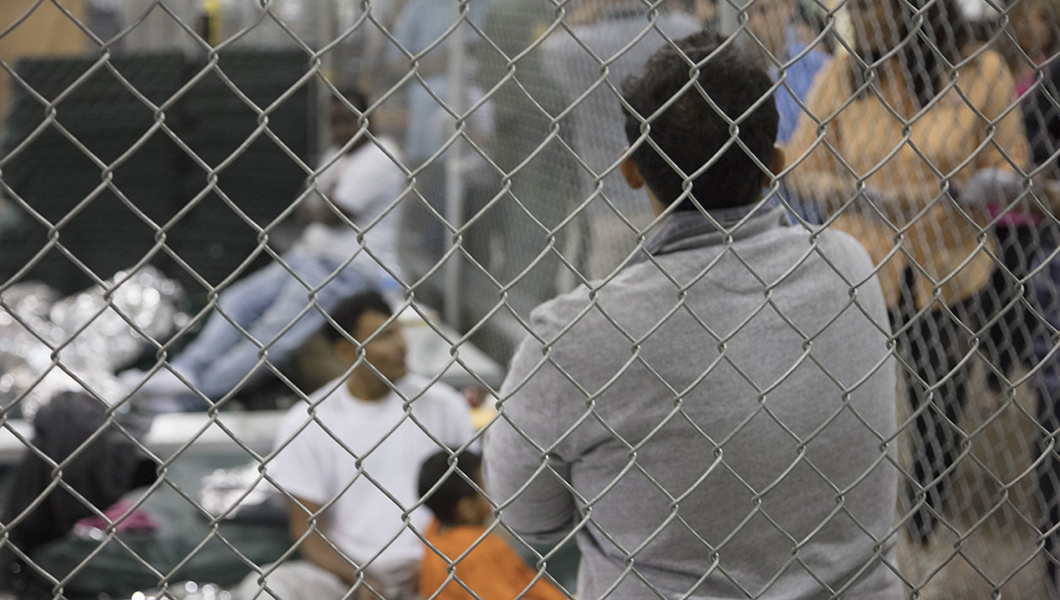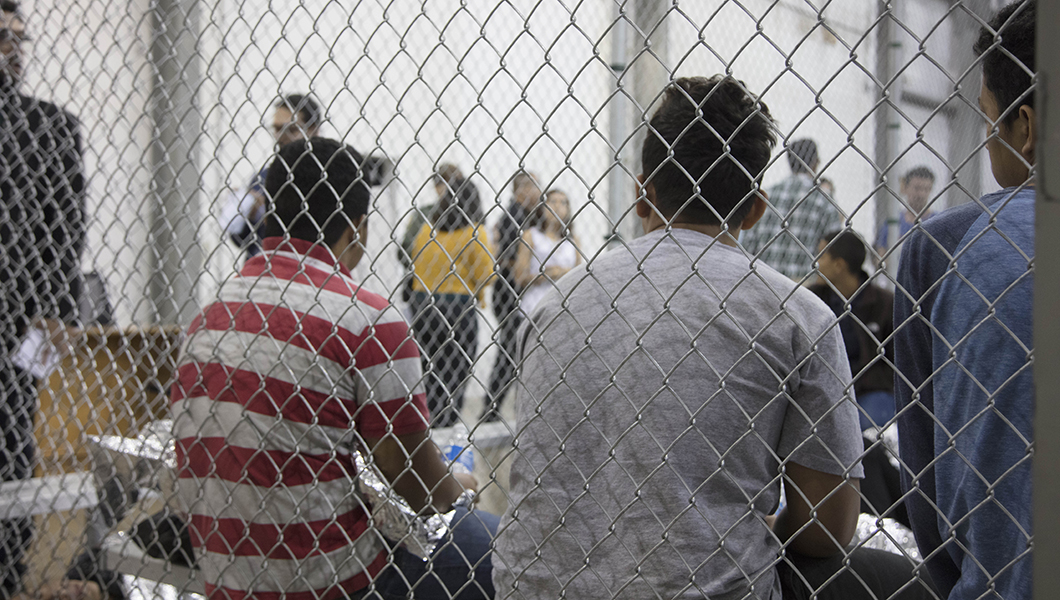MCALLEN, TEXAS — As the weekend came to a close Sunday night, Border Patrol agents in McAllen, Texas, were tending to a parentless four-month-old baby girl who had just been brought to the region’s processing center after being apprehended while crossing the Rio Grande.
It was another case of family separation, but this one was not like the thousands of others.
I saw the face of this tiny baby — wrapped in white cotton blankets, asleep in a crib — when I toured the Centralized Processing Center this week.
Hovering over the baby were three women, all government personnel. They watched over her every move as I wondered aloud how she survived the 1,200-mile journey from Honduras.
The tender-age child had been brought in late Sunday by a man who claimed to be her father, a U.S. Customs and Border spokesperson for the Rio Grande Valley Sector told the Washington Examiner.
As Border Patrol attempted to verify the family unit relationship, they realized the baby’s birth certificate was not authentic and the two were separated for the child’s safety.
As of Monday afternoon, officials still could not identify her, but said they were working with in-house consulate representatives for Honduras to figure out her story.

How the center came to be
The Centralized Processing Center, or CPC, is the largest immigration processing center in the country and was born out of the 2014 unaccompanied minors crisis that took place on the Obama administration’s watch.
As thousands of minors showed up each month at the RGV Sector in late spring 2014, CBP realized it could neither process migrants fast enough nor temporarily house the kids in the sector’s nine Border Patrol stations if the surge continued.
To help with the overcrowding, unaccompanied children were sent to Lackland Air Force Base in San Antonio, Texas; Ventura County Navy Base in California; and Fort Sill in Oklahoma.
The General Services Administration quickly started a search for a facility in the RGV that it could lease. Within weeks, the CPC found a shell of a warehouse at 3700 W. Ursula Ave. in McAllen. Just 18 days later, the 55,000 square foot building had been transformed into a processing center for up to 1,000 minors and continues to operate in a similar fashion to how it did then, down to the concrete floors, wire fencing, and green mats.
Before you enter …
The CPC has existed for four years but only recently became a national news item because of lawmakers’ trips to visit family units and children being processed inside. The public cannot go inside or even step on DHS property. Even reporters and lawmakers must apply weeks in advance to get a tour of the facility.
Border agents and officials regularly go between the administrative offices and into the separate holding areas, but must lock up their weapons before crossing into the holding rooms. Dozens of small mailbox-like metal boxes are located directly outside the entrance to the holding area, and all visitors are also required to lock up their phones, voice recorders, and cameras upon entering, which prevented me from being able to take pictures.
After passing through the lockbox hall, I stepped into a 22,000 square foot room, which houses only adults. It was renovated last July, as CBP realized it needed even more space. Children and family units are processed in the 55,000 square foot warehouse behind the adult housing facility.
The Prison Rape Elimination Act of 2003 mandated adults be separated by sex and that children also be divided by sex if the child’s relation to an accompanying adult cannot be confirmed.
The many steps in processing
When a person is brought to the center, personal items are collected and stored in clear bags until the person is transferred to a different agency or released from custody.
Then, depending on whether he or she is a lone adult or part of a family, they will be directed to one of the two large holding warehouses.
In the center of the adult holding room were interview rooms and other spaces for preliminary medical screenings, which physician’s assistants administer early on in the process.
Next, fingerprints are taken and the person will be checked against national databases to see if he or she has a criminal record in the U.S.
But in the first large room, there is also a dozen holding cells to the left and a handful to the right separated by about 20 feet and an office area where a handful of agents process new arrivals. Around 15 adult men were in each of the cells to the left. Some were sitting, some were sleeping, and others leaned against the front bars speaking to one another in Spanish as I walked by.

The adult women’s cells were about 25 percent as full as the men’s.
Due to the surge in RGV — and coupled with greater availability of resources in other sectors — Border Patrol agents from other parts of the country are also helping process detainees through a virtual processing center that is also located in this room. More than 30 computers are available for online interviews.
Once processed, adults who are not part of family units will likely be referred within for prosecution for first-time illegal entry, a misdemeanor, as a result of the Trump administration’s zero tolerance policy. All individuals, including children, family units, and adults, must be processed and released or transferred within 72 hours of arriving at the center.
Any person who requests asylum will then be referred to U.S. Citizenship and Immigration Services, but Justice Department proceedings have precedence.
A separate room for children and family units
Through the adult room is a larger warehouse where all family units are housed, including boys and girls between the ages of six and 17. Most children five and under are kept with their parents, even as those adults are being prosecuted.
This room can hold up to 1,000 people and has averaged between 500 and 700 in recent weeks, a CBP spokesperson said.
The room itself is massive, with cells in the middle portion and officers’ desks, utilities, and other items against the perimeter. There’s also a cross-shaped walkway dividing the cells.
The facility has 25-foot ceilings, giant fans blowing across the rooms, and lights that never go out for security reasons. It’s also very open, which was done intentionally so that border officers can see everything that happens inside.
In addition, portable toilets are located in the center of the room, but as a guide pointed out, one would never have known it unless they were pointed out. There was no smell despite the hundreds of people using them multiple times a day.
An outside company is responsible for taking each of the 44 porta-potties out each morning, cleaning them, and returning them to the room. In addition, the main room is cleaned three times a day, a CBP spokesperson said.

The boys’ cages are roughly 20 square feet and include three cells. For description purposes, I’ll describe it as being on the southwest side of the room. The doors are open so that they can wander between three rooms, a guide explained. One room is filled with dark green cots on the floor and benches, another is empty, and in the third, approximately 40 boys who have just picked up their lunches are sitting against the four sides of the room’s metal fencing quietly eating as a TV playing cartoons squeals in the background.
Outside the boys’ cells are four desks for consulate officers. Two of those desks are occupied by Honduran representatives who speak with each child or parent as part of processing.
On the northwest side of the room are small rooms, including one with more than 20 washing machines and 20 drying machines. There are also a handful of phones nearby available for any person to use at any time.
Order in the midst of chaos
As I passed from the northwest side where the girls were kept, they were lining up in single file at the gate to come out and pick up their lunches, consisting of a burrito, water bottle, and various snacks. A CBP spokesperson said anyone can ask for a snack at any time, and he or she will receive one. I noticed snacks on display throughout the facility. They included juice packs, peanut butter cheddar crackers, potato chips, apples, and granola bars.
Warehouse pallets of food and beverages were also stacked in corners along the southwest side.
A catering company handles meals at the facility. Officials will inform the company every morning the number of people it’s holding to ensure the right amount of food is delivered.
Family units stood in a single line, waiting to pick up food from a man behind a portable table that was topped with meals. The unaccompanied girls waited in single-line formation inside their cell until their turn.
The entire east side of the room comprised mothers with children. Just south of that holding area were desks occupied by U.S. Immigration and Customs Enforcement, which will direct 80 percent of people who are not prosecuted to their next stop. The offices handle cases seven days a week, and officers work those desks from 6 a.m. to 4 p.m., but no family unit or minor is ever released after dark.
In the midst of the chaos, back across the bustling yet fairly quiet giant room, there was a baby peacefully sleeping. And all around the room there were agents and security officers watching, waiting for an end that seems to be nowhere in sight.

